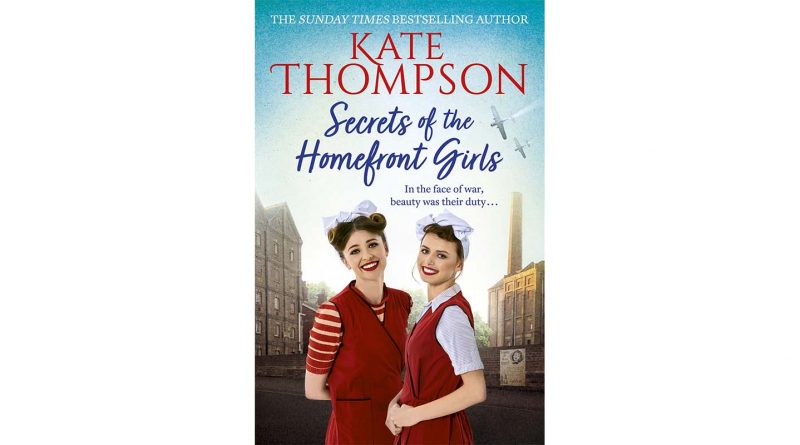Secrets of the Homefront Girls by Kate Thompson – ‘beauty was their duty’
A love letter to East London, The Secrets of the Homefront Girls shows how everyone counts whatever their gender, class or religion, says citizen journalist Kate Morse.
Kate Thompson’s The Secrets of the Homefront Girls is, among other things, a love letter to East London. If it were a more romantic form of love it might shrug off the area’s flaws, but ‘noxious, industrial’ Stratford is reflected back at us through glasses wiped clean of any rose tint.
As lively Renee puts it while travelling down Carpenters Road on the back of a trundling lorry, ‘Bethnal Green had its blind beggar, Bow its bells and Whitechapel its Ripper, but Stinking Stratford made stuff’. This is no small task when 1939 slips into war and it’s the factory women who are expected to keep up the homefront.
Set in the first years of World War Two, the novel follows the young women working at a Yardley cosmetics factory and living down a cobbled lane in the East End locally known as ‘The Shoot’.
As the effects of the war begin to take their toll and the story unfolds, it is the resourcefulness and irreverence of its cockney heroines, who work on the conveyor belt at Yardley’s, that hold it together.
It allows for complex themes to emerge and eventually steal the limelight from the book’s so-called ‘secrets’, which, it has to be said, are some of the worst-kept in London.
Any reader might easily guess the truth behind one of the novel’s most drawn-out mysteries. Although a few surprises successfully made my breath hitch, the real stars are the socio-political debates that grow louder as the book descends into the cratered depths of war. They reach a near-deafening shout in the climax of the story, down in an overcrowded basement while bombs fall overhead.
Amid the family squabbles, ‘Miss Homefront’ beauty contests (‘in the face of war’ we are told, ‘beauty was their duty’) and fragile romances, the author is in fact busy weaving in more complex topics of class and gender inequality.
When Nell Gunn, Lily and Renee’s mother and the Shoot’s ‘chief female’, is discovered to have been aiding the local women in getting abortions, this raises an interesting point on the struggle of working women. They have to raise housefuls of children while their ‘useless husbands spend all the housekeeping on beer and bets’. It also highlights the injustice of convicting a poor working-class woman for a crime that ‘Harley Street doctors’ get paid for.
Thompson portrays the resilient faces of East London’s women, who, metaphorically and at one crucial point even physically, join hands to form a formidable ‘apron-clad army’. In Nell’s words, ‘Men make and break laws, start wars, swing their dicks about and get girls in trouble’ and women are left to mop up the mess.
The novel attempts to take on the more sinister topic of anti-Semitism through our third female voice, the young Austrian refugee Esther. While haunted by her father’s absence, Esther endures insults and insinuations, and proves that her victimhood does not make her weak – if anything, she rises from it a tougher woman.
The perhaps more adeptly handled injustice, however, is the clear class discrimination that marks the government’s management of shelter and evacuation strategies in London’s poorest slums.
The Luftwaffe bombs share responsibility for the needlessness of many deaths with ‘bungling officials’ and neglectful local councils. They bully their inhabitants into inhumane conditions while, in one genuinely harrowing scene, they wait for a fleet of evacuating coaches that may as well be named Godot for all their likelihood of appearing.
Thompson explores the consequences of a system that neglects the people at the edges of society, making their lives more precarious, and ultimately more dispensable.
We are introduced to Snowball, a gentle yet homeless veteran who, discarded by society, finds some compassion in this corner of East London. Then there is Frankie, a small boy who doesn’t behave the way his brutish father expects and demands. And finally, we see the women who get pregnant out of wedlock and are forced to make impossible decisions in order not to become homeless themselves.
When Thompson writes that ‘Down the Shoot, everyone is somebody, we all count’, we feel the true impact of those words.
The ending is perhaps a little too neat, with literal ‘green shoots and sweet-smelling flowers’ growing over some of the darkest secrets buried beneath the soil, but there is just enough of a punch to it to leave you with something to think about.
If you enjoyed this review of “The Secrets of the Homefront Girls”, you might enjoy reading about The Little History of the East End.


